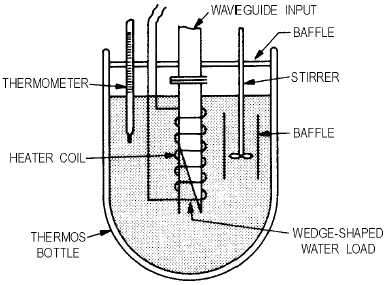3-22
Figure 3-18.—Static calorimeter using low-frequency power substitution.
The most common type of static calorimeter is the ADIABATIC calorimeter. In the adiabatic meter,
power is applied directly to a thermally isolated body; and the rate of temperature rise is determined from
a temperature change measurement during a sufficiently long, known time interval. Figure 3-19 illustrates
an adiabatic calorimeter using water as the body contained in a covered Dewar flask. A tapered-wall,
open-ended waveguide contains a sealed, inclined glass partition to create a wedge-shaped water load of
low-reflection coefficient. Thorough mixing of the water is accomplished with a stirrer, and a sensitive
thermometer measures the temperature rise. A heating coil is wound around the waveguide inside the
calorimeter and is used for calibrating purposes when low-frequency power is applied. This type of meter
can be used for accurate measurement of several hundred watts of average power and can withstand 50
kilowatts of peak power.
Figure 3-19.—Adiabatic calorimeter.



